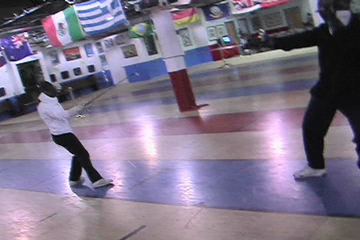
Sword Evolution: The Rise of the Rapier

Sword Evolution: The Rise of the Rapier
| About Historical Background Longsword Combat The Rise of the Rapier Misconceptions Reconstruction WMA Practice What HES Is Not Bouts Home |
Evolution (in biology,
in society, or in the arts) does not mean improvement. It means change or
adaptation to new circumstances. The changing circumstances that brought the longsword into being were technological and economic (the rise of plate armor, for example) as well as social (the rise of the knightly class). Similar forces resulted in the gradual disappearance of the longsword and its replacement by other weapons in the late 16th and 17th centuries. Gunpowder is one of those forces: It is not so much that soldiers started carrying guns in place of swords – soldiers continued to carry and use swords until the 20th century – rather, the increased thickness necessary for armor to be effective against lead shot made it too heavy to be practical, so its use waned. As armor became a thing of the past, the sword that evolved to deal with armor, the longsword, also saw the end of its usefulness on the battlefield. Thus the way was paved for a lighter sidearm for use in civilian contexts and for everyday self-defense. Starting in the second half of the 16th century, the rapier took on that role. The rapier dispensed (mostly) with the cutting role of the longsword, and concentrated on the thrust. Narrower than the longsword but about the same length, the rapier was held outstretched in front of the body, in one hand, a compound (elaborate) guard providing added protection to the hand. It was sometimes, but by no means necessarily, used in conjunction with a dagger, a shield, or cloak in the off (left) hand. The main teachers of rapier were Italian, and the fascination of the English with all things Italian meant that the England of Queen Elizabeth and Shakespeare was full of itinerant Italian fencing masters, teaching the new weapon style to all who would pay. Despite the protestations of the English martial artist George Silver, the Italian fashion in swordplay took over. The change is marked by Shakespeare in Romeo and Juliet, penned in the closing decade of the 16th century. In Act I, Scene I, Capulet asks for his longsword, and this request is intended to show that the character is old-fashioned. By that time, the rapier was de rigeur, and the young men and nobles of Italy and London mostly went about with rapiers. No self-respecting man of the time is depicted in portraits without a rapier hanging from his belt. As with the longsword, there were numerous teachers of rapier combat, including the Italians Ridolfo Capoferro and Salvator Fabris, who left detailed manuals (for information on Fabris, see The Order of the Seven Hearts). A Spanish variant style was also practiced, utilizing a very different upright stance from the lower Italian guards. In the 18th century, the sword underwent further evolution. Rapiers went out of style, and the lighter, faster smallsword, the familiar dueling weapon of the Napoleonic era, became popular. The smallsword, in turn, gave way to the dueling epee, and later the sport epee and foil used in modern sport fencing. Next page: Misconceptions |
All material copyright 2005
Eric Wargo